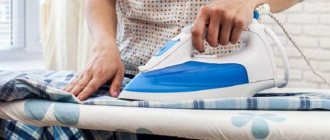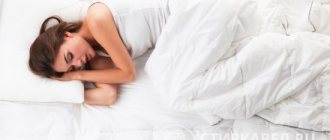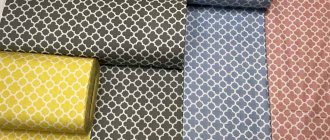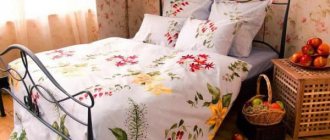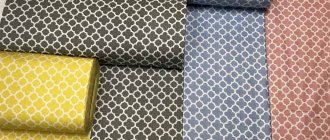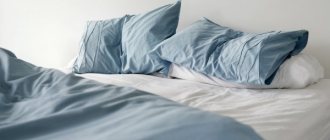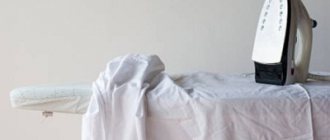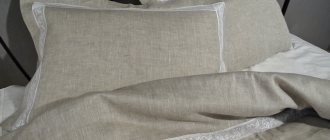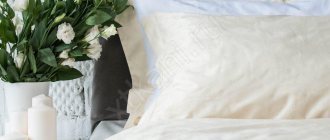A newly purchased set of bed linen pleases the eye with bright colorful colors, freshness, pleasant to the touch, crispy fabric, and there is a desire to immediately use the purchase and make the bed. Indeed: what doubts can there be if the bed is securely packed right at the factory? However, before you use sheets, pillowcases and duvet covers for the first time, you should think about whether to do it right away or to pre-wash the new bed.
Why not?
Housewives who consider washing new linen optional cite the following facts as evidence:
- new fabric does not need to be washed since it has not been used;
- packaging reliably protects bed linen from possible contamination;
- During production, the bed goes through a steaming process, which eliminates the presence of harmful microorganisms.
Attention! Not all manufacturers indicate on the labels the need to pre-wash a new bedding set, although in world practice the manufacturer strongly recommends washing it before using only purchased linen.
Wash or just iron
Many women skip step one - washing and go straight to ironing. This will protect you from bacteria, but it will not eliminate the technical smell and will not wash away the chemical treatment. The manufacturers themselves recommend washing before use - this is written in black and white on the labels. So ironing is not enough, you have to wash it. How to do this correctly next.
Why is it still necessary?
To the common question - whether to wash a new bed - the answer is clear: definitely! Manufacturers and doctors are unanimous in this opinion; it is better to follow their advice. So, what are the reasons for washing your bed before first use?
- Before getting into the hands of the buyer, the bed has gone a long way - from production to the seller. Industrial dust in a factory during production, storage on open warehouse shelves contributes to the accumulation of dust and bacteria.
- The packaging is not airtight (the bed is often packaged in cardboard boxes).
- If the linen was purchased from the market, then most likely the seller opened the package and let the buyer examine and feel the fabric.
- Natural fabrics are a good bait for dust mites, which cause skin diseases and allergies.
- New fabric, as a result of technical processing, acquires rigidity: washing will remove traces of the solution to give it a marketable appearance, help soften the bed and rid it of foreign odors.
And another important detail: after washing, the linen “shrinks” by 2-4 cm. A washed and ironed duvet cover will sit better on the blanket, and the pillow will not fall out of a clean, ironed pillowcase.
Types of fabrics for bed linen
| Natural silk | Pleasant to the touch and truly luxurious material, from which expensive bedding sets are created. The surface is slippery, so not everyone will like sleeping on it. Washable at low temperatures and only on delicate cycle. | |
| Linen | This material is considered the best for making high-quality bed linen. Does not contribute to the spread of skin diseases (fungal) and dust mites. The specificity of the material is such that in summer it cools the skin, while in winter it intensely warms. The cost of the material is high. The disadvantages include difficulty in ironing (pre-wetting the product in warm water is necessary). | |
| Flannel | Refers to a variety of cotton. It has a unique weave. The fibers on the surface help retain heat. Often used to make diapers and clothing for infants. Virtually not subject to shrinkage or deformation. If washing rules are not followed, pellets are formed, which, by the way, are easily removed. Fabric softener must be used. | |
| Satin | Thin and smooth cotton material, vaguely reminiscent of satin. Such bedding will be pleasant to the body. The surface is shiny, which is due to the double weaving of the threads. The cost exceeds calico. | |
| Poplin | The longitudinal and transverse threads of the products differ in thickness, which leads to the formation of a characteristic scar. The fabric pattern is voluminous. The characteristics of the material are similar to calico. | |
| Calico | The variety of fabrics is quite popular. A high-quality product can survive up to 300 washes in automatic mode without consequences. The fabric density is high, the surface is matte. Irons well, which makes the material incredibly practical. Washing at high temperatures is allowed. Air conditioning may be used. | |
| Chintz | Belongs to the category of natural and affordable materials. Extremely short-lived. Characterized by the presence of bright patterns that shed heavily. It is not suitable for constant use, as it quickly loses its shape and color. | |
| Cotton | Belongs to the category of natural materials. Perfectly wicks away moisture while still breathing. The material is pleasant and soft to the touch. The density indicator is influenced by the method of weaving the threads used by the manufacturer. This bedding set may contain synthetic threads, which are recommended to be avoided. Based on cotton, materials such as satin, poplin, calico and chintz are made. |
Proper washing of a new set of laundry
Let's talk about how to wash new bed linen correctly so that the result does not disappoint, but pleases you. To do this, you should follow simple rules. The new set can be washed by hand or in a washing machine. Before washing, read and follow the recommendations on the label. In manual mode, the laundry is usually soaked for 1.5-2 hours in a solution of laundry soap or washing powder. Hand wash temperature 30-40⁰C, then rinse the bed in cold water. Colored items should be washed separately.
Important! Manual mode is often chosen for washing cotton beds. You need to wring out the laundry easily, without using force, to avoid folds and creases (for example, for linen or satin). Do not use bleach for washing - they will destroy the color, but conditioner can be used for freshness and softness.
How to replace wet cleaning: myths and reality
Sometimes you want to avoid the first wash of a set. One of the suggested options is to simply use an iron without wet treatment, because high temperatures disinfect the surface.
With this choice, the following positive effects are achieved:
- The material is disinfected by exposure to high temperatures.
- The fabric becomes soft.
But there were some downsides too:
- The chemicals used to treat the fabric still remain in the fibers.
- Residues of dyes also remain in the fabric.
Regular ironing cannot completely replace the first wash, so this option is not practical.
Tips for the first machine wash
If you have a modern washing machine, washing bed linen for the first time is not difficult: the main thing is to follow the correct operating modes of the equipment. The mode is selected depending on the fabric from which the bed is made (read more about how to choose the right one here). There are general recommendations:
- Before washing, turn pillowcases and duvet covers inside out to minimize friction of the fabric on the machine drum. The sheets are folded 4 times.
- The delicate wash mode is used (for sets made of cotton or linen, “quick” is suitable), temperature – no more than 40⁰C.
- You can use capsules, liquid gel or powder.
- The rinse mode with conditioner will make the laundry soft, smell nice, and fix the color. It's a good idea to include an extra rinse.
- The bed should be wrung out at no more than 600 rpm
- You shouldn’t put several sets of laundry in the machine: the colors and patterns may get mixed up.
- Children's bedding is washed with hypoallergenic products specially designed for this purpose; it is better not to use conditioner.
Whether to wash new bed linen or not is up to each housewife to decide for herself. One thing is certain: washing will protect you from possible allergies and make your bed fresh and soft. The purchase experience will be good, and the rest on the new bed will be pleasant!
Recommendations for drying and ironing clothes
An equally important role is played by proper drying and careful ironing of the linen set after washing.
Manufacturers do not recommend that consumers use the built-in drying function in their washing machine. It is better to hang the laundry outside or on the balcony, where there is a flow of fresh air. Ultraviolet contained in bright sunlight will additionally disinfect products.
To prevent the fabric from becoming covered with creases, it must be ironed in a timely manner. Over-drying increases wear on the fabric and spoils the appearance of the laundry. When ironing, follow simple rules:
- Ironing should be done on the front side. It is recommended to work only with lace fabrics and embroidery from the inside out.
- It is not recommended to abuse the steamer. This can lead to distortion of the fabric structure.
- Silk bed linen is ironed through thin fabric from the reverse side.
- Wetting bamboo, silk or linen items with spray water may cause yellow stains. It is safer to simply iron the folds several times without using a spray gun.
Additional Information. It is better to store bed linen for a long time in vacuum bags or with silica gel. It will absorb excess moisture and preserve fabric fibers from damage.
In order to avoid problems in the form of diseases and allergic reactions when purchasing bed linen, you need to prepare it for use.
Having washed a new set of bed linen correctly for the first time, you should continue to follow the recommendations of specialists for caring for it. Then the set will delight the eye for a long time with its colors and quality of fabric.
How to wash bed linen correctly
The powder should be used of a neutral type, which does not contain bleaching elements, which will cause colored bedding to lose its original appearance. Colored linen is washed with special compounds. Before washing, the products are turned inside out. The sheets are folded several times. The washing mode is selected based on the type of material used.
Color sets are washed with the addition of:
- air conditioner;
- powder;
- active gel.
After the main mode is completed, you should add conditioner to fix the color and restart the rinse mode.
After purchasing, you should wash the following items on a delicate cycle:
- silk;
- wool.
The weight of one set reaches 3 kg, but the manufacturer indicates more detailed information on the tag.

